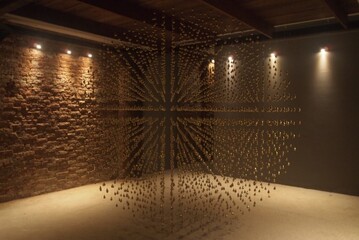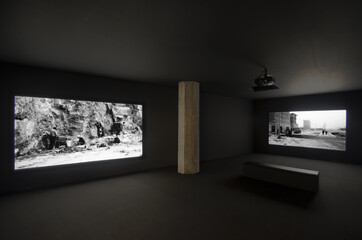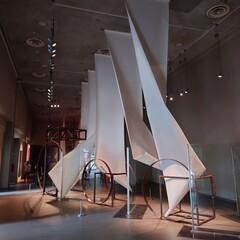Group Exhibition JAX District, Diriyah, Saudi Arabia
The title, After Rain, opens up a moment of revitalization and renewal, introducing the 2024 Diriyah Contemporary Art Biennale as a nurturing entity, filled with life, while acknowledging the necessity of water for all forms of life that dwell and seek shelter on our planet. Unfolding as a combination of practices such as inhabiting, cultivating, harvesting, searching, and sharing, this Biennale presents works that engage with the human-nature continuum, examine the built environment, observe the state of our surrounding landscapes, recount histories, and encourage us to listen more closely. Conceived as a vital entity rather than a static framework, the Biennale welcomes processes, dialogues, performances, and communal meals. The Biennale is a process shaped by first-time meetings and collaborations.
After Rain is a scent that comes from the ground. Moments before it rains—and lingering on well after—a pleasant, earthy odor permeates the air. The smell emanates from a combination of bacteria and plant oils that have accumulated in the rocks and ground during dry periods. During rain, moisture activates the bacteria to produce chemicals (geosemins) to which our noses are extremely sensitive. These, together with plant oils, are carried by the spray of splattering raindrops and the winds. Petrichor is the word scientists have coined for this familiar, luxuriant smell. The Biennale is a multi-sensory experience.
After Rain is an artistic exploration and also a conversation with scientists, architects, researchers, planners, philosophers, writers, and poets, engaging a transgenerational and multinational composition of “caretakers.” All of them shape the experience of this edition through its configuration, its dramaturgy, the knowledge each contribution brings, and the way these are communicated. Our aim with this endeavor is to create spaces of transformative encounters and exchange—spaces in which different types of knowledge foster conversations between diverse communities.
After Rain situates itself within a wider narrative of the coexistence of humans and non-humans. All life-forms are exposed to the effects of climate change—torrential rains, lack of rain, unpredictable rain—and its effects of forced displacement, the destruction of habitats and livelihoods, and the extinction of species. Concerns about access to clean water, food, and shelter have become the norm. Some artworks speak about the hardships and the need for habitation experienced during times of conflict, migration, and dislocation; others reflect on the effects of industrialization, urbanization, and environmental pollution. The ability not only to listen but also to be heard as well as the capacity to cultivate kinship are therefore essential for a livable future.
The 2024 Diriyah Contemporary Biennale, After Rain, presents artworks in all kinds of formats, across seven halls and numerous courtyards and terraces in the JAX District of Diriyah, which is situated along the area’s seasonal riverbed, or wadi. This diverse landscape enables a varied program of performances, concerts, poetry readings, and other activations across different locations and spaces, including performative and discursive spaces across Diriyah; it also extends into the digital realm.
For the second edition of the Diriyah Contemporary Art Biennale, Ute Meta Bauer has brought together a group of artists from geographies focusing on the Gulf region and Southeast Asia, where she has worked the past ten years as Founding Director of NTU Centre for Contemporary Art Singapore and Professor in the School of Art, Design, and Media at Nanyang Technological University.
Co-curator of the Biennale and full-time curator for the Diriyah Biennale Foundation, Wejdan Reda has expanded the Biennale’s narrative by developing commissions and facilitating collaborations. From photographic projects surveying desert settings and cityscapes to performative gatherings and sculptural commissions, these projects are being developed through extended conversations with local experts from different fields, including urban planners, botanists, and local chefs. Artists have been developing their contributions throughout the year through on-site research trips.
Developed by co-curator Anca Rujoiu, the Biennale Encounters is a yearlong event series of talks, conversations, workshops, collective walks, and readings; these have constituted an important component of this edition starting in April 2023, way ahead of the exhibition. Opening up a behind-the- scenes look at the core concerns of this 2024 edition, Biennale Encounters has been growing and nurturing a community around this young Biennale during the months before a wider audience is welcomed to the exhibition.
After the exhibition opens its doors, the Biennale Encounters is furthered and expanded by a performance program shaped by co-curator Rose Lejeune, which punctuates the cadence of the Biennale with events ranging from musically inspired healing sessions to spoken-word performances, sonic activations of works in the exhibition, and performances drawing from the history of theater and dance. The program includes contributions from a younger generation of Saudi and Gulf artists.
Occupying the digital realm, the Learning Garden curated by adjunct curator Rahul Gudipudi is an online space designed to extend the conceptual ground of the exhibition and its programs. It is conceived as an outgrowth and “rewilding” of topics explored by Biennale artists. It also presents materials native to digital experience and a series of commissions that intersect the research threads of the exhibition, while enabling a larger public within and beyond Saudi Arabia to engage with the Biennale.
Operating in parts of the world we are ever unfamiliar with requires an awareness of the historical, political, and contextual specificities of, in this case, a complex and fast-changing region. After Rain has the intent of creating an open map of these developments that are not easily grasped in one comprehensive picture. The word “contemporary” in this Biennale implies—not only for the artists but also for all contributors as a group—A moment, a sensibility, a scent in the air, a direct reference to a specific context and time.
More Pictures:

















